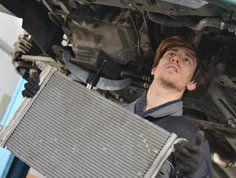1. Coolant Leaks
A clear indication that something may be wrong with your radiator is if you notice coolant leaking underneath your vehicle. Coolant will leak out of your vehicle only if your radiator or one of the associated connections has become physically damaged.
You can differentiate coolant from other fluids that may leak out of your vehicle by blotting it with paper towel: coolant has a green shade to it.
Keep in mind that your coolant may appear to have orange or brown rust spots mixed into it, which can point to rusting and corrosion within the interior of your radiator. Rust is just as large a problem as physical damage, as it will eventually eat away at the structure of your radiator. Section three of this blog discusses rust in greater detail.
2. Overheating
Beyond leaking fluids, if your radiator is no longer working as it should for whatever reason, you will experience hotter engine temperatures while driving even when traveling at moderate or slow speeds. Overheating can lead to steam coming out from under the hood in extreme cases but will most of the time only manifest itself through higher temperature readings on your dashboard.
This does not mean that an overheating engine is a superficial issue. Hotter temperatures while driving mean that your engine is not burning fuel efficiently, which can lead to reduced gas mileage and higher monthly expenses as you have to fill up your tank more often.
Higher temperatures can also increase the risk of a mechanical failure within your engine. Then you may be faced with a much more expensive and complicated repair than just having your radiator replaced.
3. Rust and Physical Damage
As mentioned above, if you notice that your coolant has flecks of rust in it, you should take a look at your radiator to see if it has rust on the exterior. Minor rust spots may not be a cause for concern, but if your radiator is covered in corrosion, it likely needs to be replaced.
You should also take a quick look at the hoses that are connected to your radiator for signs of cracking or splits - even if they haven't fully formed yet. Wear to the hoses is one of the primary sources of coolant leaks, so when they begin to crack with age, you should have them replaced.
4. Sludge
Beyond actual damage to the radiator in terms of cracks and broken components, you should also keep an eye out for sludge and discolored fluid. Open up the coolant reservoir, and either use the dipstick or peer into the reservoir to determine the quality of your coolant fluid.
Sludge in your radiator can prevent coolant fluid from flowing through your coolant system, which can lead to engine overheating as mentioned above.
For any questions that you might have about your car's radiator, please don't hesitate to contact us at Kell Radiator Service. Our team of skilled auto repair specialists will be able to help you get your car running as good as new again in no time.



